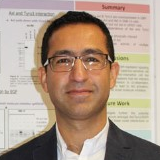Receptor Tyrosine Kinases 2021
A special issue of Cells (ISSN 2073-4409). This special issue belongs to the section "Cell Signaling".
Deadline for manuscript submissions: closed (15 November 2021) | Viewed by 3755
Special Issue Editor
Interests: epigenetics; focal adhesion proteins; receptor tyrosine kinases; cell signalling; vitamin K; cancer; myelin; multiple sclerosis; brain tumours; renal carcinoma; cytoskeleton; cell migration
Special Issues, Collections and Topics in MDPI journals
Special Issue Information
Dear Colleagues,
Receptor tyrosine kinases (RTKs) are a large superfamily of transmembrane receptors that play pleiotropic roles in both health and disease in cell, tissue, and organismal levels. RTKs show diversity in their extracellular ligand-binding regions, which enables their classification into 20 subfamilies. Moreover, there is a wide array of diverse ligands that can activate different RTKs, with varying selectivities and potencies. However, all RTKs have in common an intrinsic tyrosine kinase activity within their intracellular regions, which enables coupling to a variety of intracellular signalling pathways. Normal RTK function is associated with development, cell survival, growth, differentiation, cell–cell and cell–matrix interaction, and immune regulation. However, abnormal RTK activity and/or expression is a common feature in pathologies, including many cancers.
Ongoing research into RTKs covers a broad range of topics, including ligand-dependent and -independent receptor activation, receptor clustering, spatial and temporal control of RTK signalling, RTK intracellular functions, potential as entry gateways for infectious pathogens, negative regulation and recycling, and as highly attractive targets for cancer. The aim with this new, the second Special Issue of Cells, is to offer a collection of scholarly reviews and original articles that expand and update our knowledge on this important group of proteins. In this way, we hope to provide a stimulating resource for students and professionals on the breadth and impact of RTK biology. This area is sure to hold great interest across academic, industrial, and health sectors, not only for increasing our knowledge on the fundamentals of cellular biology, but also for its huge potential for translating to developments in medicine and diagnostics.
Dr. Sassan Hafizi
Guest Editor
Manuscript Submission Information
Manuscripts should be submitted online at www.mdpi.com by registering and logging in to this website. Once you are registered, click here to go to the submission form. Manuscripts can be submitted until the deadline. All submissions that pass pre-check are peer-reviewed. Accepted papers will be published continuously in the journal (as soon as accepted) and will be listed together on the special issue website. Research articles, review articles as well as short communications are invited. For planned papers, a title and short abstract (about 100 words) can be sent to the Editorial Office for announcement on this website.
Submitted manuscripts should not have been published previously, nor be under consideration for publication elsewhere (except conference proceedings papers). All manuscripts are thoroughly refereed through a single-blind peer-review process. A guide for authors and other relevant information for submission of manuscripts is available on the Instructions for Authors page. Cells is an international peer-reviewed open access semimonthly journal published by MDPI.
Please visit the Instructions for Authors page before submitting a manuscript. The Article Processing Charge (APC) for publication in this open access journal is 2700 CHF (Swiss Francs). Submitted papers should be well formatted and use good English. Authors may use MDPI's English editing service prior to publication or during author revisions.
Keywords
- receptor tyrosine kinases
- growth factor
- ligand
- signal transduction
- phosphorylation
- spatial and temporal signalling
- kinase domain
- transmembrane domain
- dimerisation
- docking protein
- development
- differentiation
- immunity
- cancer
- monoclonal antibodies
- small molecule kinase inhibitors
- tumour drug resistance
- ubiquitination
- hetero-dimerisation
- oncogene
- gene fusion
- endocytosis
- coreceptor






